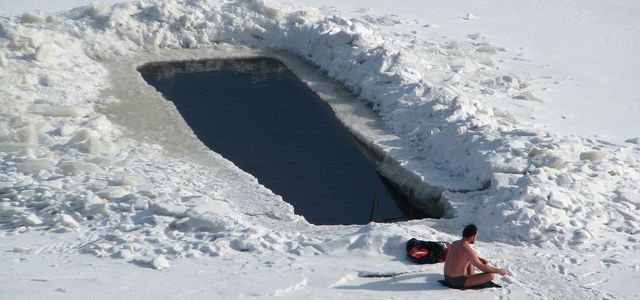
In icy temperatures into the water: Ice bathing is becoming increasingly popular. Here you can find out how to bathe safely in winter and whether it is good for your health.
When the thermometer shows low temperatures and at the latest when the first snowflakes fall, the bathing season is over. For most of them, anyway. Because the fans of ice bathing wait longingly until it gets icy.
In this article, we’ll explain what ice bathing is, how it affects your body, and what to look out for.
What is ice bathing?
In ice bathing, you immerse your body up to your head for a few seconds or minutes in water, which has temperatures of almost zero degrees. The cold fans promise themselves from the limit experience strong immune system and a healthy circulation. Ice or winter bathing has a long tradition in Russia, among others. But the trend is spilling over to Germany: According to the Süddeutsche Zeitung, there are around 3,000 ice swimmers nationwide: indoors.
The “Wim Hof method” is popular among the more advanced. The bathers breathe in and out deeply, which is intended to alleviate the cold shock. Then they hold their breath for a short time. Wim Hof - the inventor of the method – is a Dutch extreme athlete who regularly exposes himself to freezing cold and extreme situations. So he ran barefoot a half marathon in the Arctic Circle and climbed Kilimanjaro – wearing only swimming trunks.
Ice bathing – healthy or dangerous?

Proper sauna is known to strengthen the immune system. The body is exposed to extreme heat. Can a reverse stimulus, i.e. cooling the body, have the same effect?
Science has yet to find a clear link between ice bathing and a better immune system. However, there is a study that shows that winter bathing fun trains the blood vessels. The fact is that when immersed, the vessels in the skin constrict and more blood flows into the widened, inner blood vessels. With this mechanism, the organism ensures that the core temperature is maintained. The increased blood flow (hyperemia) has a stabilizing effect on the Blood pressure and the Cardiovascular system. The study also describes that ice bathing or cold swimming have positive effects on the patient Insulin levels and may affect other hormones as well. In a further study, health improvements also occurred in rheumatism, fibromyalgia or asthma through winter bathing.
Ice bathing also releases adrenaline and endorphins. They provide that special “kick” and a euphoric feeling after the bath. This effect could be the long-term mental health to serve. However, this does not necessarily require the extreme situation: Studies suggest that regular cold showers also help against depressive moods, as the body releases beta-endorphins and norepinephrine in the process.
At the same time, researchers warn that untrained ice swimmers can die while bathing in ice: be it because of the initial neurogenic cold shock reaction, because of a progressive decrease in swimming performance or because of hypothermia.
You should pay attention to this when you go ice bathing

Doctors warn against too much cold at once. The body should Step by step get used to the extreme of winter swimming. Wim Hof also recommends cold or variable showers in the morning to get started. You can find out how healthy cold showers are in our article Take a cold shower: it’s so good for your health Experienced.
Ice bathing can be life-threatening for inexperienced or sick people. It is advisable to have one before taking a cold bath See a cardiologistto rule out possible heart defects. If you have cardiovascular problems, you should refrain from ice swimming, as the cold shock can lead to cardiac arrhythmias or cardiac arrest.
Besides, you should never alone go swimming. If the worst comes to the worst, help is essential. Since holes are often punched in the ice cover of a lake, especially when ice bathing, experienced supervision is also highly recommended here. There are cases when people suddenly disappear under the ice and can only be recovered dead.
You should also adhere to the following points before, during and after ice swimming:
- Only go ice bathing when the visibility is clear and the weather is calm.
- Jog According to the recommendation of the information site www.eisschwimmer.de for about 15 minutes before ice bathing to warm up.
- We lose a lot of heat through our heads – so just dive in up to the chest and put on a hat!
- If you have sensitive hands, you can wear gloves. They protect the skin from cold and dehydration.
- Take a short bath: The icy bath shouldn’t last longer than five minutes.
- Then quickly put on warm clothing.
- If possible, have some hot tea or coffee and go to a warm room.
Read more on Techzle.com:
- Cold sauna: effect and functionality
- How cold balm protects you in winter – and 4 recommended brands
- 7 common winter mistakes – and how to avoid them